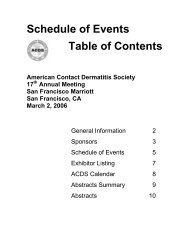American Contact Dermatitis Society 21 Annual Meeting
American Contact Dermatitis Society 21 Annual Meeting
American Contact Dermatitis Society 21 Annual Meeting
Create successful ePaper yourself
Turn your PDF publications into a flip-book with our unique Google optimized e-Paper software.
Prevalence of Aluminum Allergy in <strong>Dermatitis</strong> Patients<br />
Victoria Kuohung, Pamela Scheinman, Department of Dermatology, Tufts Medical Center, Boston MA<br />
Objective: To present eight out of 372 dermatitis patients who tested positive to aluminum chloride 2%<br />
petrolatum on patch testing.<br />
Materials and Methods: A retrospective data analysis was performed on 372 consecutive dermatitis<br />
patients patch tested in an IRB-approved database from November 2008 to November 2009 at Tufts<br />
Medical Center. All patients were tested with aluminum chloride 2% petrolatum plus a modified North<br />
<strong>American</strong> <strong>Contact</strong> <strong>Dermatitis</strong> Group (NACDG) standard, fragrance and preservative series. Other series<br />
were tested if warranted by history and physical exam. Readings were performed after 48 and 72 hours,<br />
and graded according to the NACDG system.<br />
Results: Out of 372 patients, eight (2.2%) had reactions to aluminum chloride. Three were male and five<br />
were female, with patient ages ranging from three to 79 years old. Of these eight patients, four were six<br />
years old or younger. Three of these four children demonstrated 3+ reactions. Five patients (62%) were<br />
atopic, five showed concomitant reactions to other metals, and two had generalized dermatitis. All were<br />
Caucasian.<br />
Conclusions: This is the first examination of aluminum allergy prevalence in a United States database of<br />
dermatitis patients. Potential sources of exposure to aluminum include aluminum-containing vaccines,<br />
cookware, lotions and deodorants. A European study more than one decade ago found aluminum allergy<br />
prevalence at 0.2%. The tenfold increased prevalence reported here suggests that further studies are<br />
warranted.<br />
Development of photosensitivity after allergic contact dermatitis to epoxy resin<br />
Kwok T 1,2 , DeKoven JG 2,3 , Rosen CF 3,4<br />
1 Schulich School of Medicine, University of Western Ontario, London, Ontario, Canada<br />
2 James R Nethercott Occupational Disease Specialty Program, St. Michael’s Hospital, Toronto, Ontario,<br />
Canada<br />
3 University of Toronto, Toronto, Ontario, Canada<br />
4<br />
Division of Dermatology, Toronto Western Hospital, Toronto, Ontario, Canada<br />
Persistent photosensitivity with a decrease in the Minimal Erythema Dose to UVB and UVA following<br />
ACD has rarely been reported.<br />
We describe a healthy 40-year-old female train car painter with longstanding ACD to epoxy. She avoided<br />
recurrence of her ACD for 8 years by becoming a welder and refraining from working with epoxy paints.<br />
Unfortunately, after inadvertent workplace airborne exposure to epoxy, a severe dermatitis developed on<br />
her face and torso. Repeat patch testing to the North <strong>American</strong> Standard Series revealed a 2+ reaction<br />
to epoxy resin. Following a flash burn while welding, a rash developed on photoexposed areas of the<br />
patient’s head and neck. The eruption worsened while outdoors on days the sun reflected off the snow.<br />
Significant exacerbations were later noted in the spring and summer. Phototesting revealed a<br />
decreased MED to UVA and UVB, with 1+ reaction to 10 mJ/cm 2 UVB at 8 hours and 2+ reaction at 24<br />
hours, and a 1+ reaction to 4 J/cm 2 UVA at 8 hours and a 2+ reaction at 24 hours persisting to 72 hours.<br />
Photopatch tests to the North <strong>American</strong> Standard Series were negative.<br />
Our patient developed marked photosensitivity to UVB and UVA after experiencing a severe workrelated<br />
allergic contact reaction to epoxy. We advised photoprotection with clothing, hats, sunscreen and<br />
sun avoidance, Mylar filter treatment of her car's windows, and work restrictions. The photosensitivity<br />
persists 3 years after diagnosis. Other cases of persistent photosensitivity after ACD to epoxy and<br />
possible mechanisms will be discussed in this presentation.<br />
19






